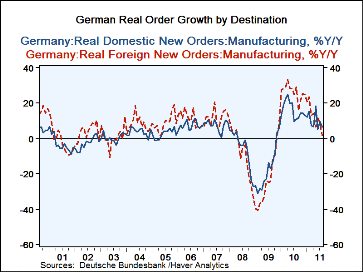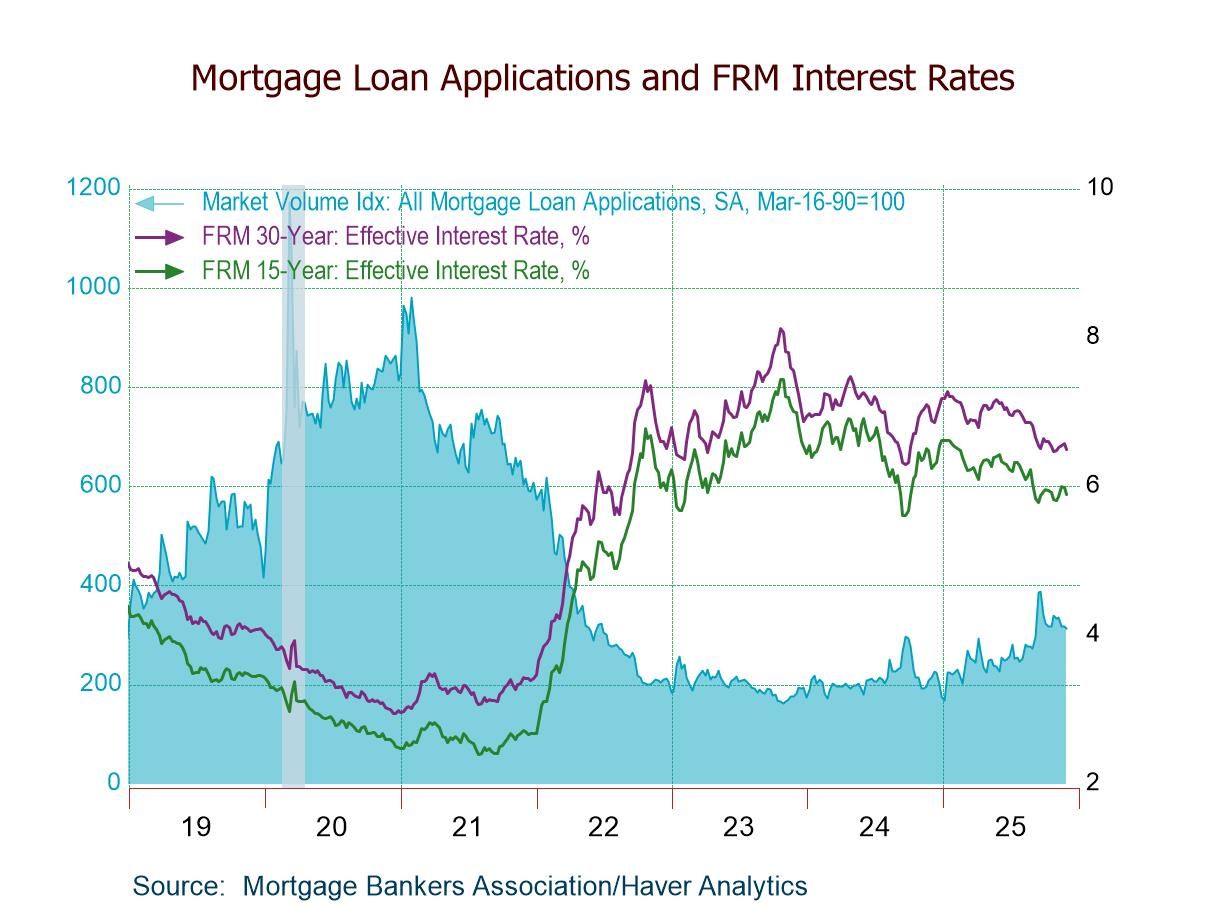 Global| Oct 06 2011
Global| Oct 06 2011German Order Growth Spirals Lower
Summary
German industrial orders have fallen for the second month running. In July plunging foreign orders took the headline for orders growth into negative territory but in August it was weak domestic orders that dragged the series into [...]
 German industrial orders have fallen for the second month running. In July plunging foreign
orders took the headline for orders growth into negative territory but in August it was weak
domestic orders that dragged the series into contraction. It’s always something.
German industrial orders have fallen for the second month running. In July plunging foreign
orders took the headline for orders growth into negative territory but in August it was weak
domestic orders that dragged the series into contraction. It’s always something.
Despite the fact that foreign orders show an odd 12-mo to 6-mo to 3-mo accelerating trend that seems more the product of some odd serendipity that a slice of reality order growth is slowing down. Domestic orders have on the same growth sequence taken a large step lower.
The broader Yr/Yr trends depicted in the chart take the broader perspective where the overarching trend is most clear. It shows both the series’ volatility as well as the clear downward trend for each on annual percentage changes.
Germany is the traditional strong country in EMU and it is under a great deal of stress. Germany’s growth metrics are still at or near the best of the Zone but its gauges of growth are weakening. Weak conditions in adjoining states as well as ongoing concerns about debt conditions and the prospects for knock-on effects are taking a substantial toll on growth and investor and consumer attitudes. In Europe investors are looking for investment safe-havens to protect capital instead of looking at ways to make capital grow. Risk is off the investment table because so much of risk encroaches on everyday life.
| German Orders and Sales By Sector and Origin | ||||||||
|---|---|---|---|---|---|---|---|---|
| Real and SA | % M/M | % SAAR | ||||||
| Aug-11 | Jul-11 | Jun-11 | 3Mo | 6Mo | 12Mo | YrAgo | Q-2-Date | |
| Total Orders | -1.4% | -2.6% | 1.8% | -8.6% | 4.1% | 3.6% | 20.5% | -7.7% |
| Foreign | 0.1% | -7.2% | 13.1% | 21.4% | 4.2% | 1.5% | 29.0% | -6.8% |
| Domestic | -3.2% | 3.7% | -10.1% | -33.6% | 4.3% | 6.6% | 10.8% | -8.3% |
| Real Sector Sales | ||||||||
| MFG/Mining | -0.4% | 4.0% | -0.1% | 14.4% | 7.2% | 8.5% | 11.1% | 17.2% |
| Consumer | -1.5% | -1.3% | 2.9% | 0.0% | -0.6% | 2.3% | 1.0% | -7.7% |
| Cons Durables | -8.8% | 11.5% | -3.8% | -8.6% | -3.8% | 4.3% | 8.0% | 18.4% |
| Cons Non-Durable | -0.2% | -3.3% | 4.0% | 1.7% | 0.0% | 2.0% | -0.1% | -11.3% |
| Captial Gds | 1.5% | 7.0% | -0.4% | 36.7% | 14.8% | 12.9% | 14.5% | 39.7% |
| Intermediate Gds | -2.1% | 2.5% | -0.5% | -1.0% | 1.9% | 7.1% | 13.3% | 5.2% |
| All MFG-Sales | -0.4% | 4.0% | -0.1% | 14.4% | 7.3% | 8.5% | 11.2% | 17.2% |
Robert Brusca
AuthorMore in Author Profile »Robert A. Brusca is Chief Economist of Fact and Opinion Economics, a consulting firm he founded in Manhattan. He has been an economist on Wall Street for over 25 years. He has visited central banking and large institutional clients in over 30 countries in his career as an economist. Mr. Brusca was a Divisional Research Chief at the Federal Reserve Bank of NY (Chief of the International Financial markets Division), a Fed Watcher at Irving Trust and Chief Economist at Nikko Securities International. He is widely quoted and appears in various media. Mr. Brusca holds an MA and Ph.D. in economics from Michigan State University and a BA in Economics from the University of Michigan. His research pursues his strong interests in non aligned policy economics as well as international economics. FAO Economics’ research targets investors to assist them in making better investment decisions in stocks, bonds and in a variety of international assets. The company does not manage money and has no conflicts in giving economic advice.






